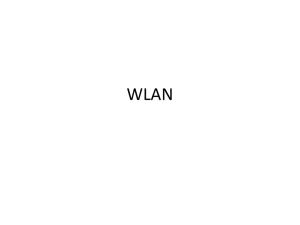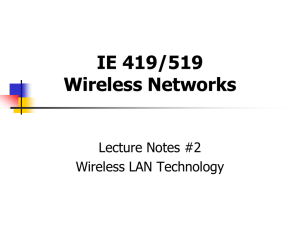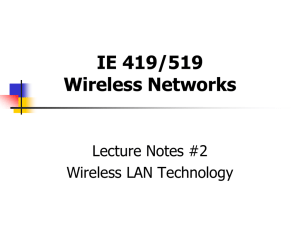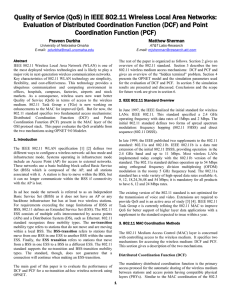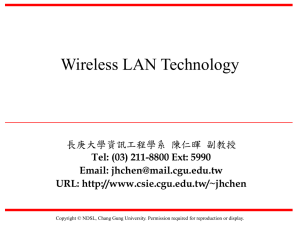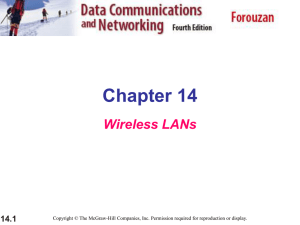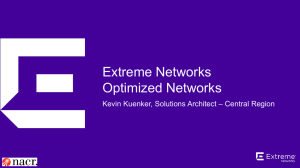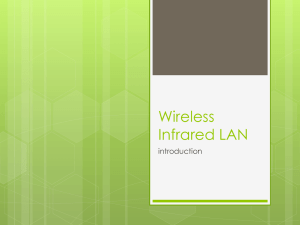Faculty of Computer Science & Engineering
advertisement
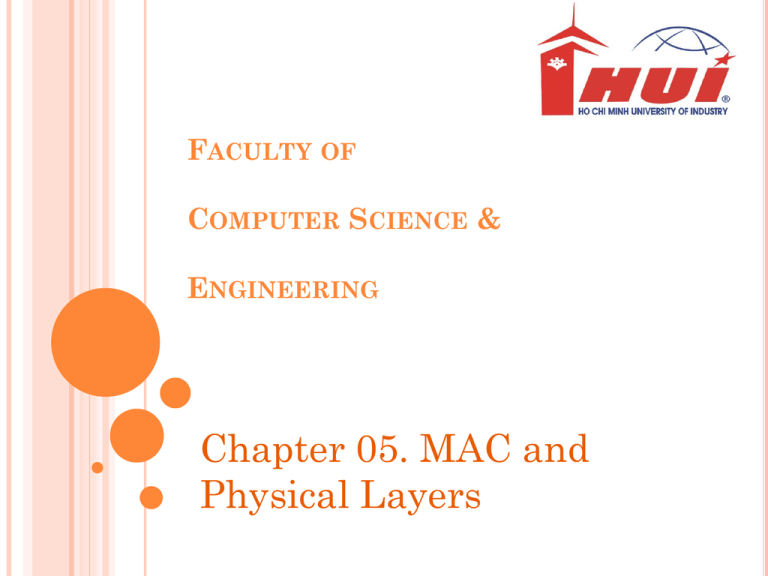
FACULTY OF COMPUTER SCIENCE & ENGINEERING Chapter 05. MAC and Physical Layers QUESTION 1 1. Which of the following service sets can use distributed coordination function (DCF) mode? Choose all that apply. A. BSS B. IBSS C. ESS D. IESS QUESTION 2 2. Which of the following service sets can use point coordination function (PCF) mode? Choose all that apply. A. BSS B. IBSS C. ESS D. IESS QUESTION 3 3. You have a large number of users on one access point and collisions are becoming a problem, causing reduced throughput. Some of the users are developers that do a significant amount of large file transfers during the day. Which RTS/CTS setting would best fix this problem? A. On B. Off C. On with threshold QUESTION 4 4. Which one of the following is an advantage to using point coordination function (PCF) mode over distributed coordination mode (DCF)? A. PCF has a lower overhead than using DCF B. PCF can be used in and IBSS while DCF cannot C. PCF uses CSMA/CA while DCF does not D. PCF provides a given level of QoS QUESTION 5 5. After a client station sends a data packet to another client station, the receiving station replies with an acknowledgement after which interframe space? A. IFS B. SIFS C. PIFS D. DIFS QUESTION 6 6. Why is the CSMA/CA protocol used in order to avoid collisions in a wireless LAN? A. PCF mode requires use of a polling mechanism B. The overhead of sending acknowledgements is high C. All clients must acknowledge packets received while they're asleep D. It is not possible to detect collisions on a wireless LAN QUESTION 7 7. End stations will broadcast a _______ when actively scanning for access points on the network. A. Beacon management frame B. Superframe C. Probe request frame D. Request to send QUESTION 8 8. PIFS are only used during the communications of a wireless LAN when which of the following have occurred? A. The network is in point coordination function mode B. The access point has been configured to use RTS/CTS C. The access point has been configured to use CSMA/CD D. The network is configured for fragmentation QUESTION 9 9. You have just finished installing your first wireless LAN with 802.11b equipment rated at 11 Mbps. After testing the throughput of the clients, you find your actual throughput is only 5.5 Mbps. What is the likely cause of this throughput? A. Wireless LANs use RTS/CTS by default B. Wireless LANs use the CSMA/CA protocol C. Use of PCF is reducing network throughput D. DRS has caused all of the clients to decrease their data rates QUESTION 10 10. You have just finished installing your first wireless LAN with 802.11b equipment rated at 11 Mbps. After testing the throughput of the clients you find your actual throughput is only 5.5 Mbps. What can you change to get 11Mbps throughput? A. Turn off RTS/CTS B. Move all of the clients closer to the access point C. Turn up the power on the access point D. Purchase another access point and co-locate both together QUESTION 11 11. 802.11b devices use what type of modulation at 11 Mbps? A. BPSK B. DPSK C. QPSK D. CCK QUESTION 12 12. 802.11a devices use what type of modulation at 24 Mbps? A. BPSK B. 16QAM C. OFDM D. CCK QUESTION 13 13. If the sending station on a wireless LAN does not receive an ACK, the sending station assumes which one of the following? A. The receiving station is sleeping B. The receiving station is a hidden node C. There was a collision D. That RTS/CTS is turned on QUESTION 14 14. Modulation is which of one of the following? A. The process by which digital data is modified to become RF data B. The process of adding data to a carrier by altering the amplitude, frequency, or phase of the carrier in a controlled manner C. The process of propagating an RF signal through the airwaves D. The means by which RF signals are received and processed by RF antennas QUESTION 15 15. Which one of the following is not part of a superframe? A. Beacon B. Beacon Free Period C. Contention Free Period D. Contention Period QUESTION 16 16. A superframe is used when which of the following is true? Choose all that apply A. The access point has been configured for point coordination function mode B. When beacons are disabled in the access point C. The wireless clients have been configured to announce to the access point that they are pollable D. The access point has been configured for distributed coordination function mode QUESTION 17 17. What is the purpose of the superframe? A. To increase the throughput of all wireless LANs B. To ensure QoS for all voice and video applications running on wireless LANs C. To ensure that PCF- and DCF-mode clients do not communicate within the same wireless LAN D. To allow fair co-existence between PCF- and DCFmode clients on the network QUESTION 18 18. The acronym CCA stands for which one of the following? A. Close Client Association B. Clear Current Authentication C. Clear Channel Assessment D. Clean Channel Association E. Calculate Clear Assessment QUESTION 19 19. The Network Allocation Vector (NAV) acts as: A. A timer on the station B. A navigational feature for RF signal propagation C. A location discovery tool for wireless LANs D. A tool for allocating the bandwidth of a wireless LAN QUESTION 20 20. Using RTS/CTS allows wireless stations to do which of the following? A. Broadcast their intent to send data across the network to the receiving station B. Send their packets across the network at the maximum rated speed of the network C. Eliminate hidden nodes on the network D. Diagnose and reduce high overhead between stations
